This is the second post in a two-part series where we recap our third year of nomadic travel.
We learned a lot from our very unplanned third year. We discovered wonderful places, people, and cultures (make sure to read part one to learn more about that). This year was also filled with so much uncertainty – we didn’t even know which countries we would be staying in, let alone how much budget we would need. We were able to still save a lot as we continued applying our money-saving strategy (through tactics such as booking long-term Airbnbs, eating locally, living slowly, applying for credit cards to travel for free, and more…) to keep our budget to a very affordable number. In this post, we are going to share and dive into every single penny we spent (because we love tracking that stuff!).
Are you ready to know whether or not we break the bank in our Year 3 of nomadic travel during a pandemic? Where did we splurge the most and how did this year compare to year 2?
Some links to the products mentioned below are affiliate links, meaning that if you click and make a purchase, Nomad Numbers may receive a commission at no additional cost to you. For more information please review our disclaimer page.
How much did we spend in Year 3 of nomadic travel?
(Note: if you are new to this blog and want more context about our spending as nomads, check out our previous reports including our 1st year of nomadic travel and our 2nd year of nomadic travel)
Let’s get into the meat of this post: for our Year 3 of nomad travel, we spent about $32K! (or $32,022.50 to be exact).
Here are details about this total cost with a breakdown between living and non-living expenses:
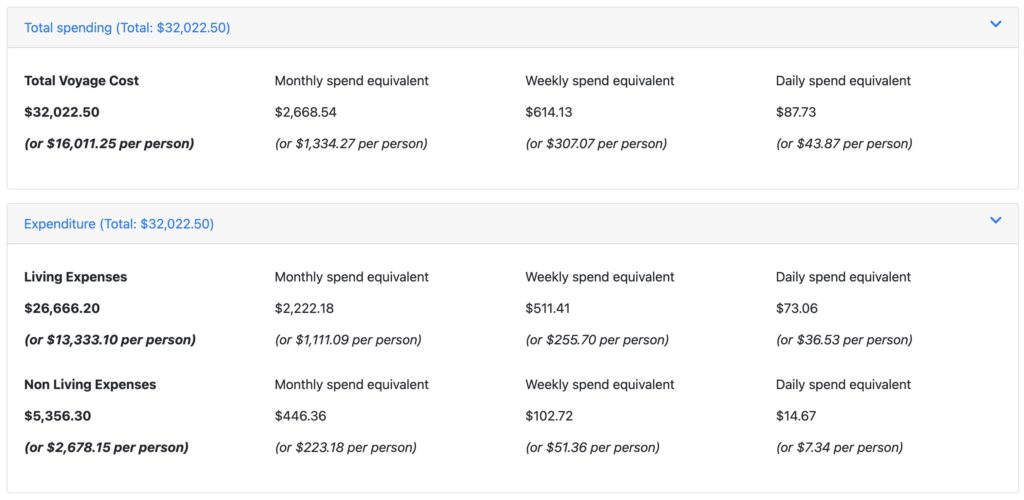
This is an average of $2,668 per month for the two of us. Back in California, this would barely cover our rent and utilities!
Note: We like to track living and non-living expenses as we are building a public cost of living index for each country we visit so we have an idea of what our budget would be if we would like to spend an extended period of time in a city we fall in love with).
Spending per category
While $32,000 for a full year of nomadic travel might not seem a lot, it is actually the most we have spent since we started our full-time nomadic travel.
Because it wasn’t obvious for us why we spent more, we had to dig into each of our spending categories to get a better picture. So let’s take a look together at our spending per category that we grouped into major buckets (ordered from the biggest ones to the smallest one):
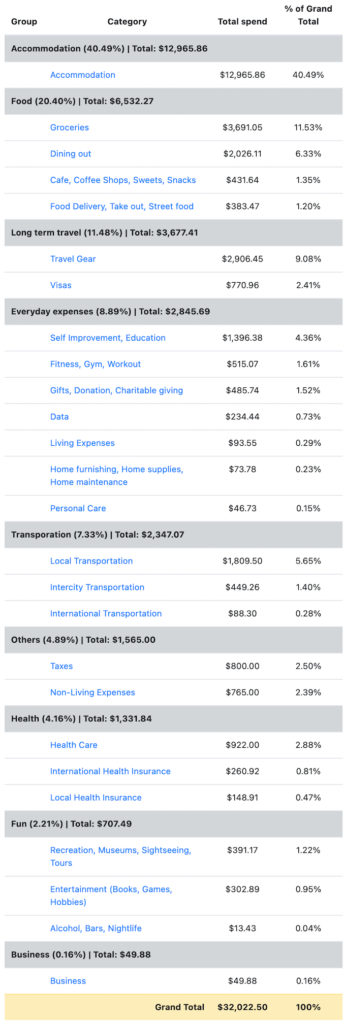
The first thing to notice is that out of the 9 groups and 25 categories we used to track our spending, 80% of our spending fit into only three buckets: Accommodation (with $12,956 or 40%), Food (with $6,532 or 20%) and Long term travel (with $3,677 or 11%) and Everyday expenses (with $2,845 or 9%).
Note: for us, transportation never makes it to the top three spending buckets as it only represents 7% of our total spending. This is probably due to the fact that 1) we do not own a car, 2) we relied mostly on public transportation, and 3) we extensively use travel rewards by opening credit cards to pay nothing when it comes to international flights (which are usually expensive travel items).
Let’s dig into each major bucket:
Accommodation: $12,965.86 / year (or ~$1,080 / month)

We rented an Airbnb in Taipei for 9 out of 12 months during that year for about $1,000 / month. The remaining $4,000 was spent on rentals we booked as we traveled around Taiwan. During our last month, we stayed with Mrs. NN’s parents so we did not get to pay rent for that month.
With a monthly budget of $1,178 / month (adjusted to 11 months since we did not pay rent in June), we are definitely well under the $2,500 rent + utilities we used to pay to live in San Francisco(with rent control!). And as you can see in the picture below, we get a really nice place that is centrally located in the heart of Taipei.
Good to know: we could have signed up for a 6+ months lease and reduced our accommodation budget further but we decided to stick with a month-to-month Airbnb to have the option to leave it when we wanted to travel within the country.
Food: $6,532.27 / year (or $545 / month)
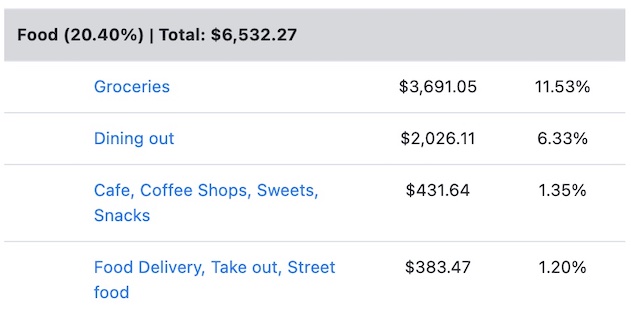
As a couple who follow a 16:8 intermittent fasting schedule we usually skip breakfast and only eat lunch and dinner w/ a snack in between.
This year we enjoyed about 77 dinners and 86 lunches at sit down restaurants as well as 123 meals that we enjoyed on the go (either while visiting a street food market – with our zero waste kit, as to-go food for lunch during a day spent outside when we did not feel like packing our own food or just as regular take-away). This represents nearly 300 meals (or about 40% of our overall food consumption – assuming 2 meals/day over a year) that we did not cook ourselves.
On top of that, we have a sweet tooth as we apparently purchased about 200 snacks or sweet items mostly from cafes. Half of these were bubble milk tea that I really enjoyed in Taiwan!
We spent a total of $2,841 for an entire year with an average cost for a meal at a restaurant of $12, $3 for a take out and $2 for a sweet treat.
The food is so inexpensive and delicious in Taiwan that we could have easily consumed every meal outside (especially since there was no COVID on the island). However, we like to prioritize our health and we know it isn’t very healthy to consume all of our food outside since you have limited control on the ingredients and cooking methods(vegetable oil for instance is really bad for you and a lot of restaurants cook with it because it is really cheap). So we don’t mind spending more money on an apartment with a good kitchen to cook and spend the time to go grocery shopping (we did 285 grocery runs during that year and spent $3,691 eating delicious food at home.
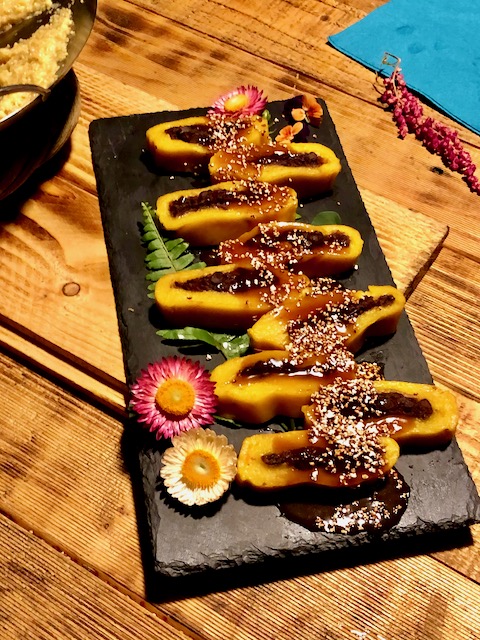
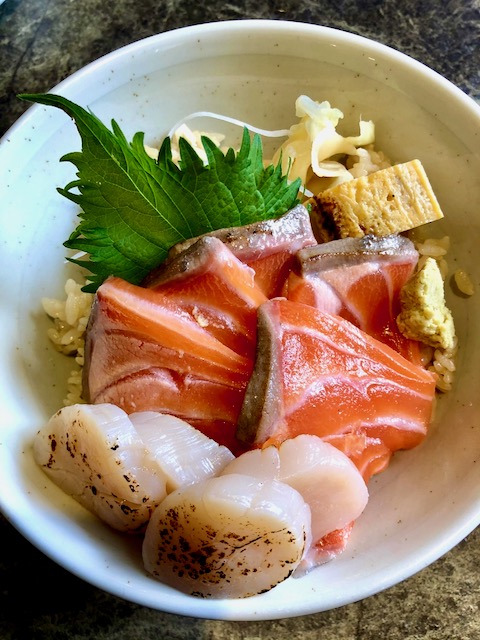
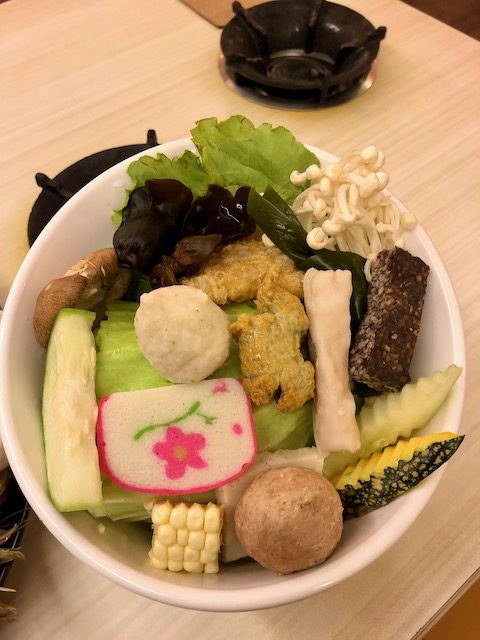
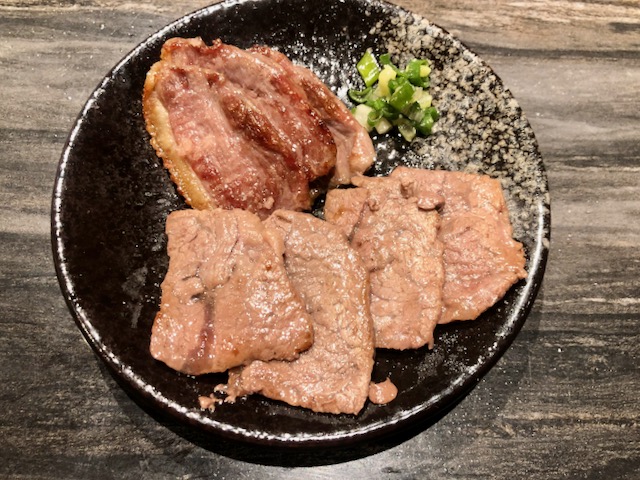
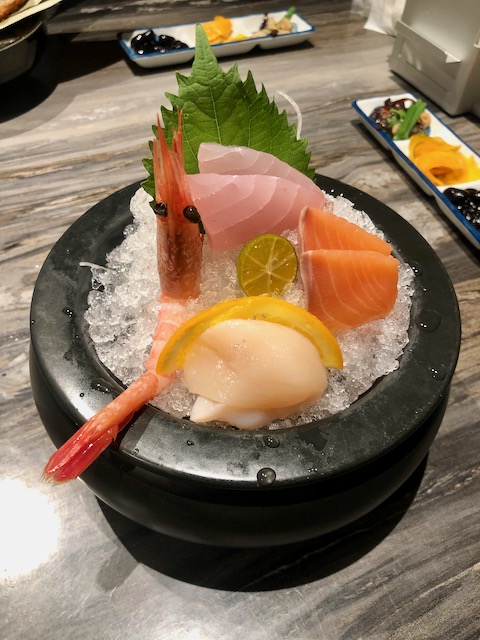
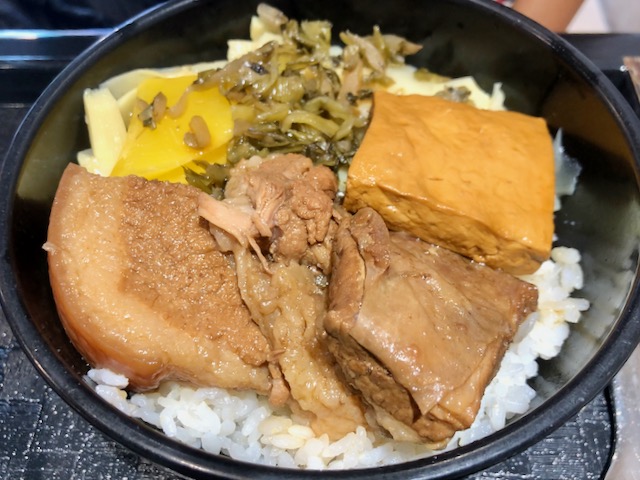
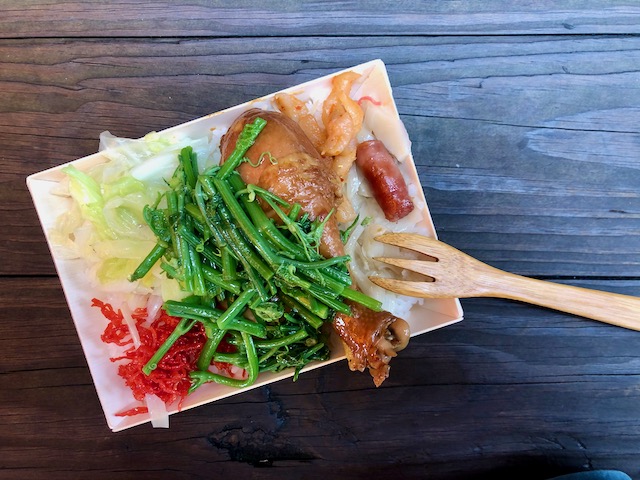
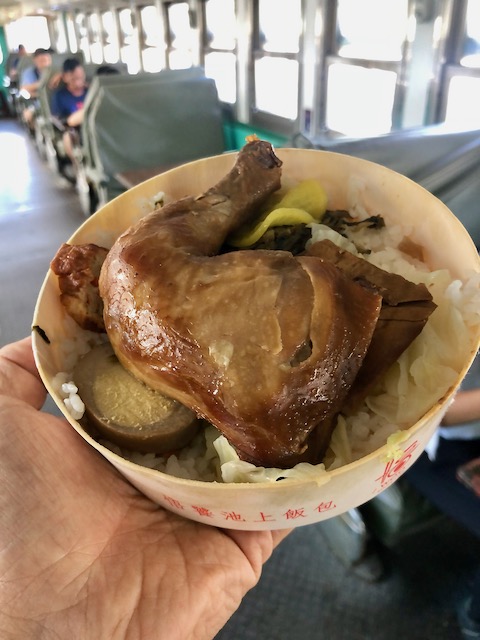
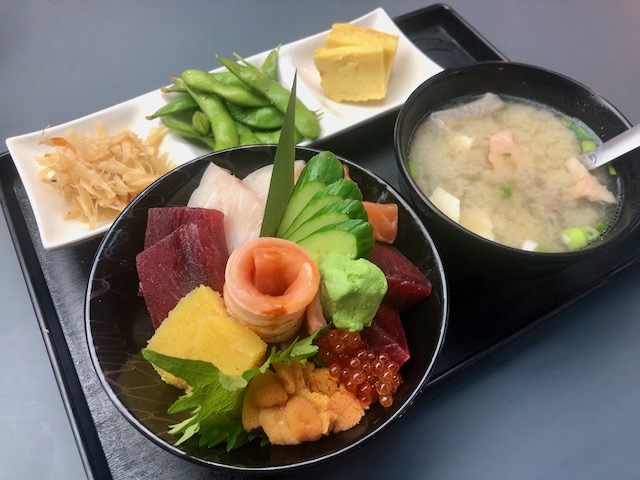
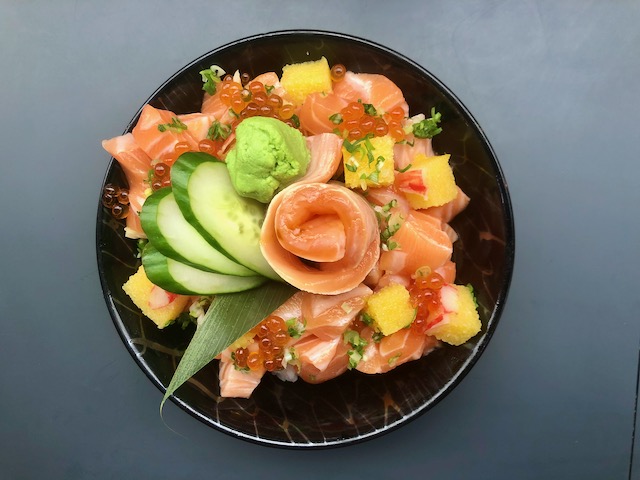
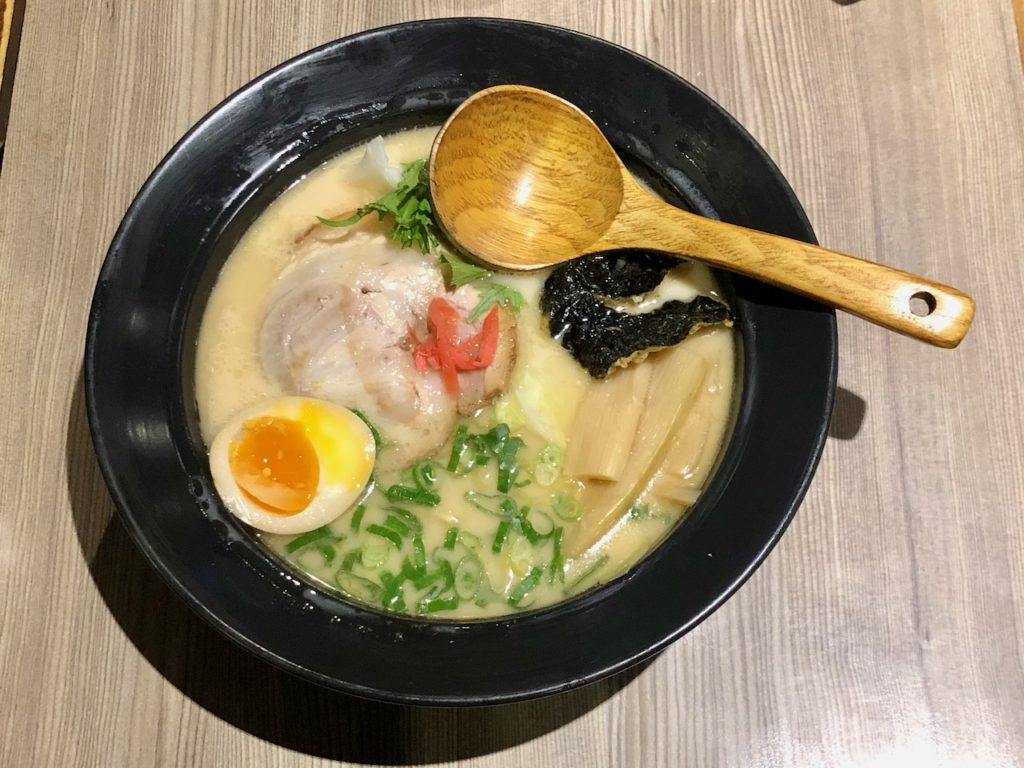
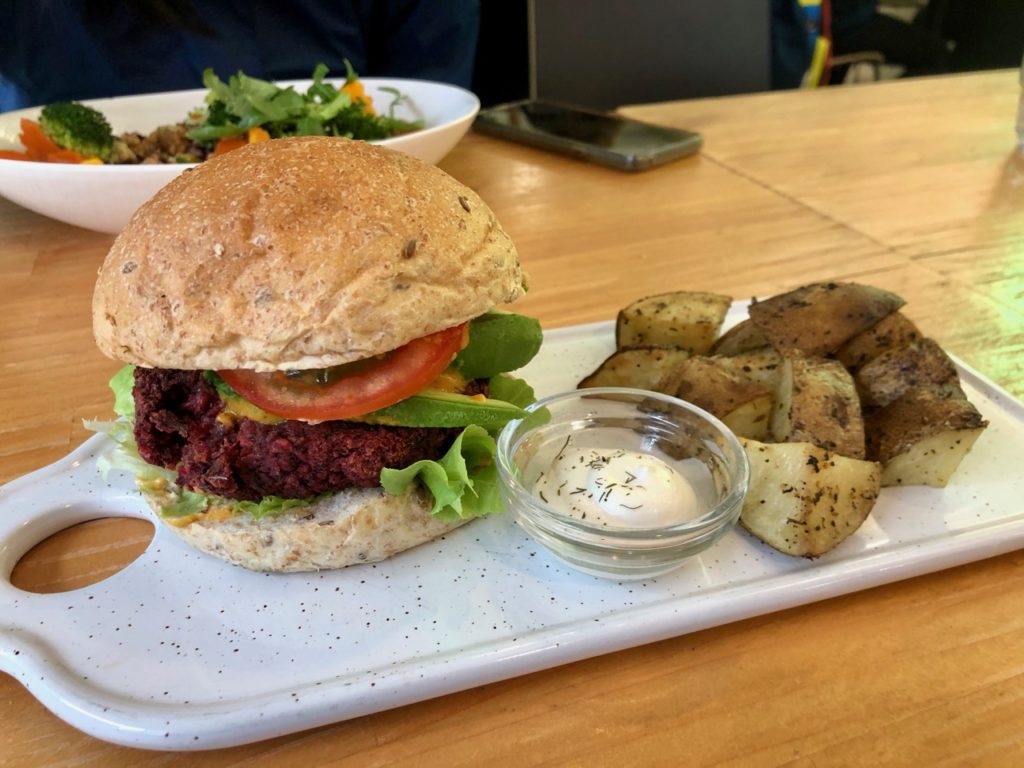
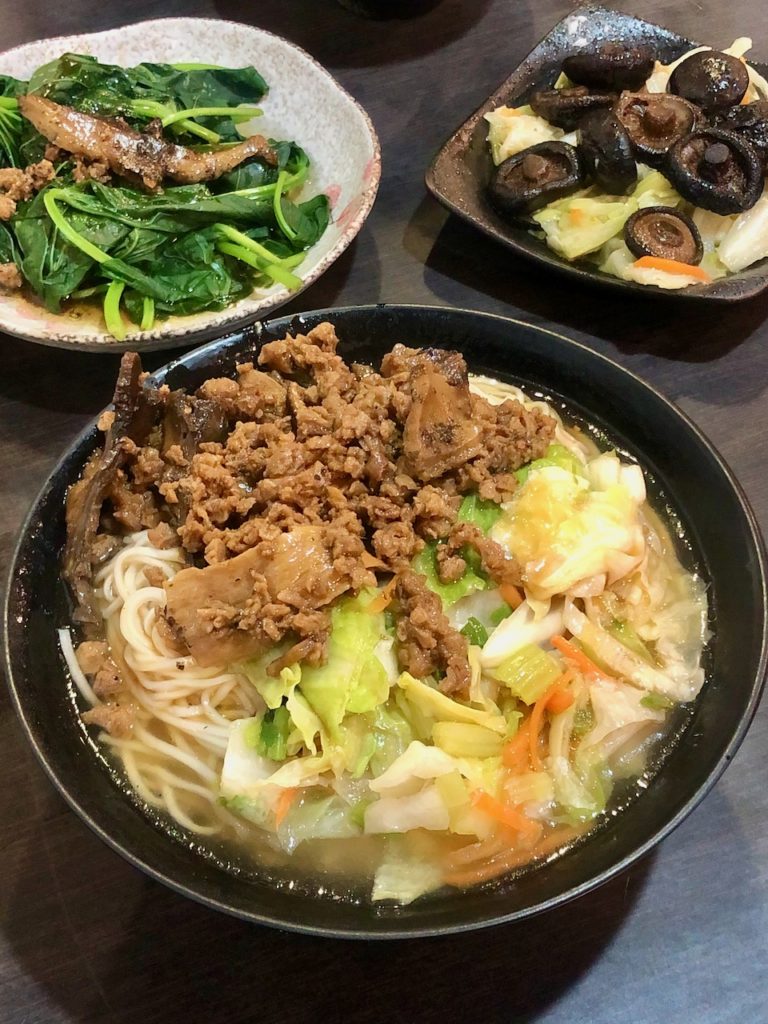
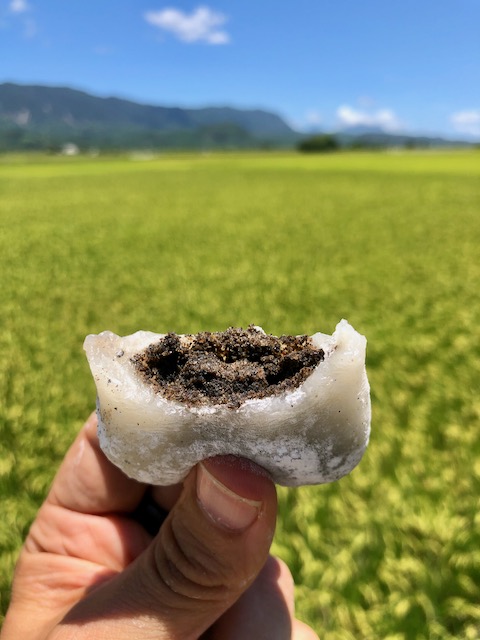
Mochi
Long term travel: $3,667.41 / year (or ~$306 / month)

This represents our spending related to our long-term travel stuff, which is mostly our travel gear and our visas. Travel gear this year included some clothing, as well as some electronics, with the most expensive items being the following:
- Insta 360 X2 Camera – Ideal for great 360 videos and photos
- Remarkable II Paper Tablet – A really good replacement of our paper notebook (use this link for $40 off)
- Sandisk SSD Drives – They are sturdy, they can easily fit in your pocket and let us store all of our travel footage
We also spent about $600 to get two Taiwan Gold Cards (one for each of us) and some smaller expenses related to our visas as nomads.
Everyday expenses: $2,845.69 / year (or ~$237 / month)
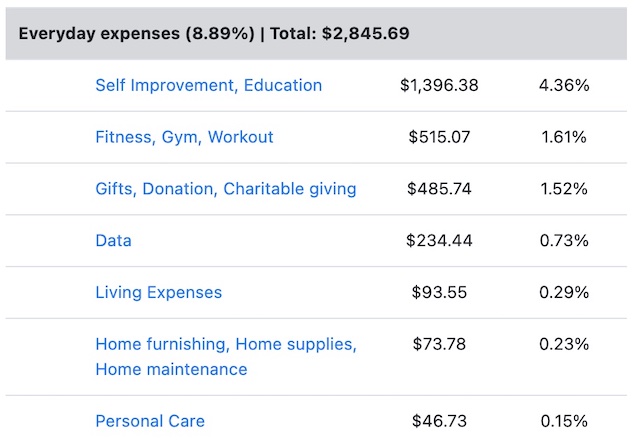
This group includes our day to day expenses:
- Self Improvement, Education: We invested $1,400 in learning Mandarin while in Taiwan.
- Fitness, Gym. Workout: Most of this spending went for a second-hand giant bike that I have been using to explore Taiwan and also spending time swimming at the public pool to train for a Triathlon I did in April 2021
- Gift, Donation, Charitable giving: pretty self-explanatory
- Data: This includes our Google FI phone plan + Google Drive subscription. Note that since we spent most of the year in Taiwan that has crazy cheap phone plans, we paused Google FI during our time in Taiwan and reduced our bill from $40 / month to $10 / month.
- Living Expenses: a bunch of misc everyday expenses that could not fit anywhere else
- Home furnishing, supplies & maintenance: some plans for our Airbnb along with some Kombucha-making items as Mrs. NN successfully got into making this fizzy and healthy beverage at home.
- Personal care: mostly getting our hair done 🙂
Transportation: $2,328.47 / year (or $195 / month)

Most of this budget went into using the amazing public transportation system of Taiwan to move within Taipei (via buses and subway) as well as around the island (via the train, buses, and also city bikes!).
Our International Transportation is low since we only took one international trip from Taipei to San Francisco. Though as you can see we only pay a very small amount as we use miles to book this 12+ hours flight! We managed to achieve this thanks to travel rewards redemption (aka travel hacking) that lets us book most of our international flights with points instead of cash.
New to travel rewards? Check out our 2020 End of Year Travel Rewards Report to see how we accumulated half a million travel rewards in that year alone! If you want to start earning free travel money, do not miss our travel rewards article where we share our strategy and help you get started within minutes ).
International Health Insurance: $1,331.84 / year (or ~$111 / month)

For our third year of nomadic travel, we did not purchase international coverage that was part of our health insurance strategy as nomads since we spent most of the year in Taiwan, which has an extremely inexpensive out-of-pocket health care system. For more on that read: The true cost of healthcare as nomads.
It is also important to note that 2/3 of our healthcare cost went into getting 2 PCR tests prior to leaving Taiwan (they aren’t subsidized) and some very extensive blood + metal toxicity panels I did as part of my yearly health check routine. Without them, our Health Care cost would have been around $300 – most of that amount was paid out-of-pocket since we did not get access to Taiwan Health Care until mid-March of 2021.
Note on the Taiwan National Health Care: 6 months after receiving our Taiwan Gold card, we became eligible for the Taiwan National Healthcare which brings our out-of-pocket cost down from something like $30 for a dentist visit to about $3. The premium cost is $30 / month and per person (if you are not working and have close to a zero deductible) for comprehensive and world-class healthcare. This makes us not want to return to the US long-term from a healthcare standpoint!
Fun: $707.49 / year (or $59 / month)
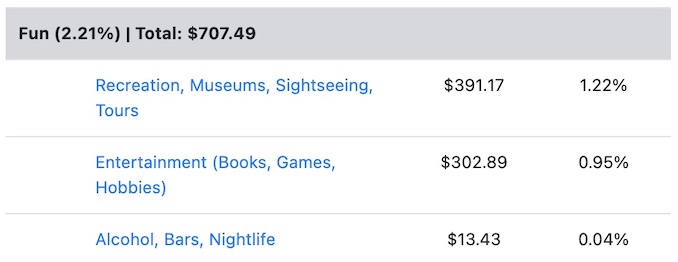
Snorkeling, scuba diving, triathlon, island boat tour, musical performance, and movies (yeah even during COVID19) were some of the fun activities we’ve paid for in Taiwan.
While we are having a lot of fun, it turns out that most of the things we enjoy are actually not on this list since they are free! Like hiking or river tracing that we enjoyed several times each week! I guess that is a benefit of loving nature since it is free for everyone 🙂
Spending per destination
Let’s now take a look at all the destinations we’ve visited during Year 3. We’ve put together the cost of living for each of the places with the daily budget extrapolated over an entire year.
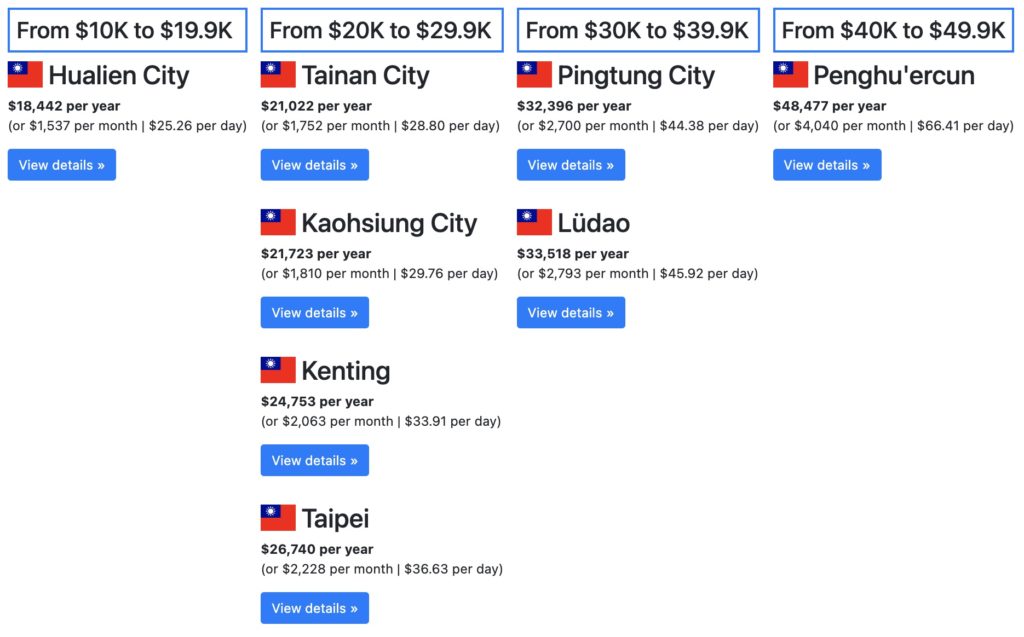
As you can see, Taipei, where we spent most of our time, has a really affordable cost of living – well under $30,000 per year for a couple. Also, the majority of the places outside of Taipei are actually cheaper. Penghu island was where we treated ourselves for our wedding anniversary, so the price there was only based on a week-long trip. This island would definitely be more affordable than the projected $48K / year for a couple.
Note: To stay consistent in our reporting, we only include the living cost in these estimates. Keep in mind that during Year 3, we spent about $5,000 in non-living expenses.
A reminder about the power of geo-arbitrage (especially during a pandemic)
As we are tracking living costs in each country we’ve been traveling to, we can estimate what a full year of living in the country would be like. At a time when the world is in a global pandemic, this might be useful to decide where we want to spend an extended period of time (dependent on travel restrictions).
As you can see on the table above, 5 out of the 8 places we stayed at would cost us under $30K if we would stay a full year and one of them would cost us below $20K.
Spending per month
Looking at our expenses on a monthly basis, we roughly spent the same amount each month, except on May 2-21 when we had to double pay for accommodation (Taiwan/California) and pay for some emergency PCR test costs as we rushed our departure from Taiwan a month ahead of our initial schedule due to a small yet scary outbreak.
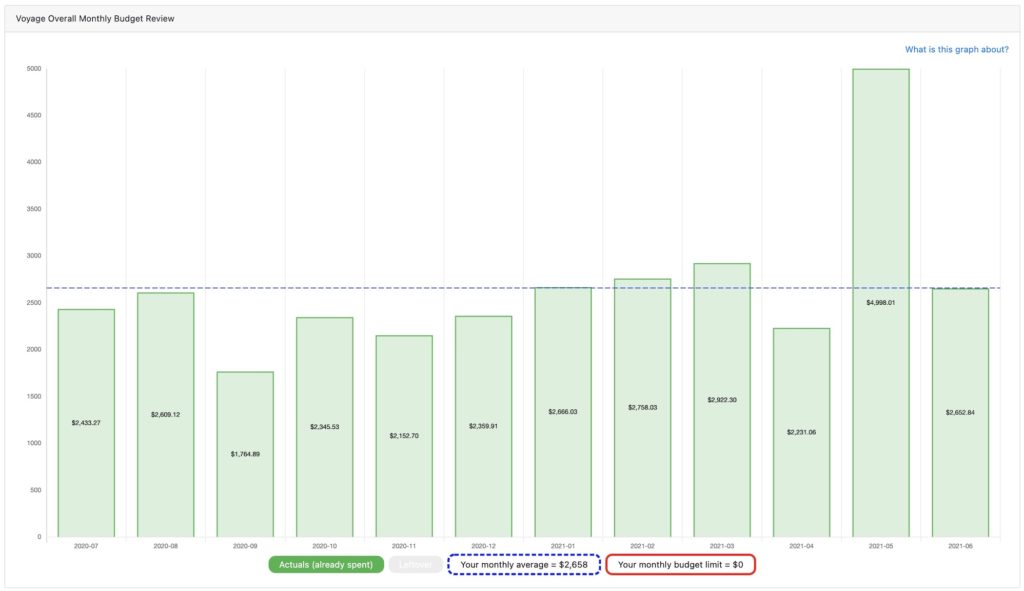
Spending Year 3 vs Year 2
Let’s look at a side-by-side comparison to see the major differences between Year 3 and our previous year

Notable categories where we spent more money than during Year 2:
- Travel gear: $2,906 vs $234 (a 12X increase!) – Year 2 was pretty lightweight on the travel gear side since we loaded up on everything we needed during Year 1. As we came back home at the end of Year 3, we accumulated a list of items we wanted to purchase.
- Self Improvement, Education: $1,396 vs $231 (a 6X increase!) – As we settled in Taiwan during the pandemic, we had the benefit of being able to take Chinese classes(especially MrsNN) which account for most of this category
- Visas: $770 vs $204 (a ~4X increase) – As we settled in Taiwan, we needed a long-term plan which was the Taiwan Gold Card that we paid upfront for 3 years at the beginning of Year 3. At about $300 per person for a 3 years residency, the Taiwan Gold Card is really inexpensive when you account for all the benefits you get (access to great healthcare, multi-entry permit, work permit, ability to bring your parents to the country…) – Read our Taiwan Gold Card Detailed Guide for all the details.
- Local Transportation: $1,809 vs $1193 (a 1.5X increase) – Since we spent the entire year in Taiwan, we moved around a lot, hence more spending in this category.
- Groceries: $3691 vs $2610 (a 1.4X increase) – This is an interesting one as we do prioritize eating most of our meals at home. This increase might be related to the pandemic and our quarantine where we did eat more at home than usual. This might also be related to the fact that Taipei is more expensive on grocery shopping than places we stayed at in Year 2.
Notable categories where we spent less money than during Year 2:
- Dining out: $2026 vs $3005 (a 3X decrease) – Since we ate more at home because of the pandemic, this might explain why we spent less on dining out. But also Taiwan has pretty really cheap food when it comes to eating out.
- Recreation, Museum, Sightseeing, Tours: $391 vs $897 (a 6X decrease) – Not a big difference in dollar amount. We still feel that we’ve been enjoying activities like scuba diving, island tours and private hot springs.
- International Health Insurance: $260 vs $3149 (a 9X decrease) – We drop our expat insurance since we got access to Taiwan’s really affordable healthcare system, which has led to a massive saving on that front that we can benefit from until the summer of 2023 (current expiration of our Taiwan Gold Card)
- International Transportation: $88 vs $1786 (a 20X decrease) – Well because of the pandemic, we did not fly internationally, except to return to California in May, which we paid with miles and only paid taxes/fees using our credit card.
What do we expect for Year 4 of our nomadic life?
From a budget standpoint, we are targeting a 30-40K budget for the upcoming year. If anything, our investment strategy has sustained during the pandemic and we have been deliberately quite conservative in our first few years to test things out. We are likely to spend 30K USD at the minimum but are open to spending up to 40K since it’s hard to plan ahead where we will be by the end of Year 4. We want to be optimistic that travel will be safer and more open but we are also prepared to hunker down in one place if needed.
Want more details?
If you are interested to get more details about the budget related to each place we’ve visited, please take a look at both our destination reports & weekend guides (we link most cities at the beginning of our article). We share detailed spreadsheets with both consolidated and line-by-line items of what we’ve spent.
All of the images in this article came from Nomad Purse, the travel tool that we launched in 2019. If you sign-up you will gain full access to all of our expenses. You will also be able to use the tool to track all of your travel expenses and we now have an Android mobile companion application to make it even easier to capture your expenses while on the go (even if you are in the middle of nowhere with no data!).
Our bottom line
Since we started our nomadic lifestyle, we’ve explored much more than we’ve done the prior 10+ years but at the same time, there’s still so much to explore as you can see in the places we’ve been to since July 2018.
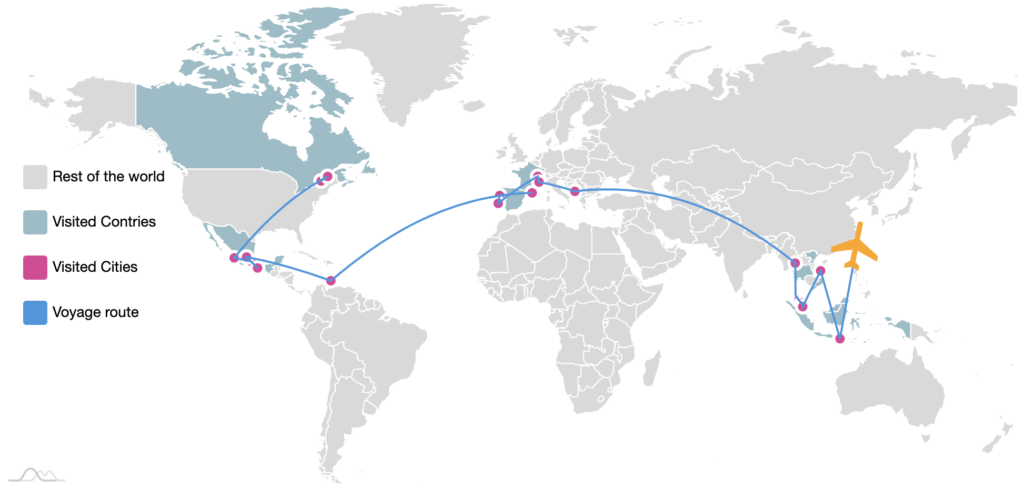
Besides exploring, we are less stressed and having a lot of fun roaming the planet, one city at a time. We’ve also adopted some new routines (like journaling)
This lifestyle also gives us the freedom to spend our time on the things we care about like reading some life-changing books, learning new skills, starting projects we are excited about (like this blog, sharing stories on Instagram, creating some cool drone footage video on our Youtube channel and even being featured in some pretty cool podcasts or websites).
And as you’ve just seen, slow and nomadic travel can be much cheaper than staying at home!
Want to get started on slow travel? We have plenty of resources for you. First, start by reading our destination reports and weekend guides. If you like what you are reading and want to prepare for it, learn our tactics (like how we handle our physical mail while being away from home for so long, how we got a very affordable phone plan anywhere we go, what we have in our carry-on packing list for long-term travel. And don’t forget to review our previous spending reports to show that this life can be more affordable than most people think!
If you have been traveling long-term or plan on doing so, definitely let us know what you think about our numbers. Do they align with your expectations? We would love to hear from you, so please leave us a comment in the comment section below.
Stay safe and never stop exploring!
Mr. & Mrs. Nomad Numbers
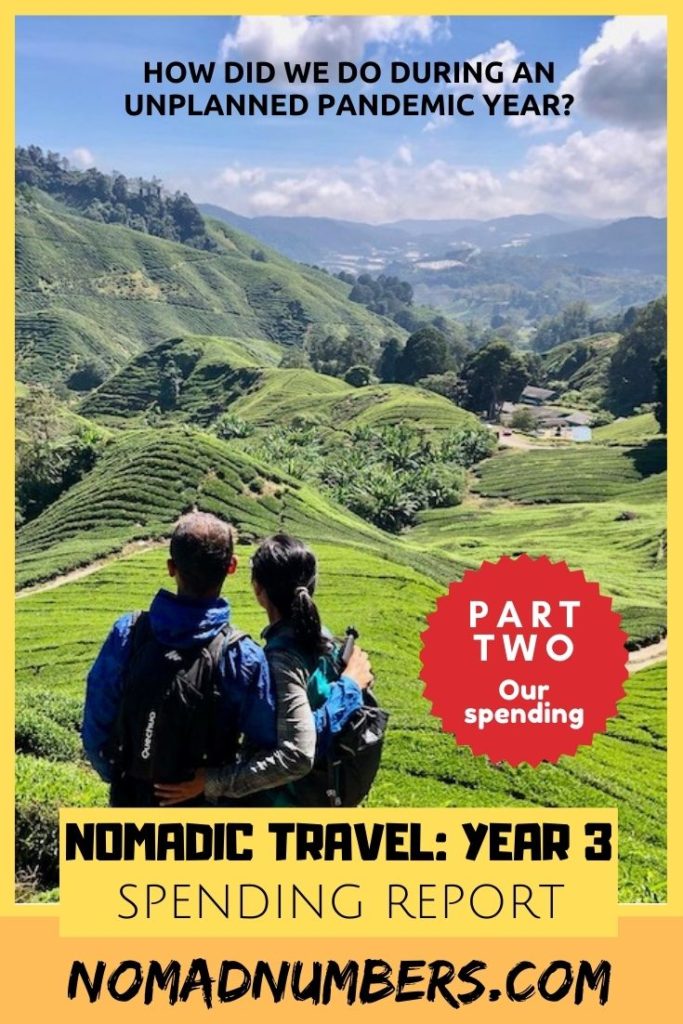
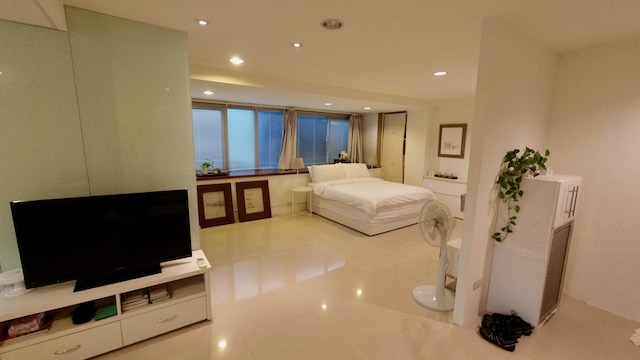
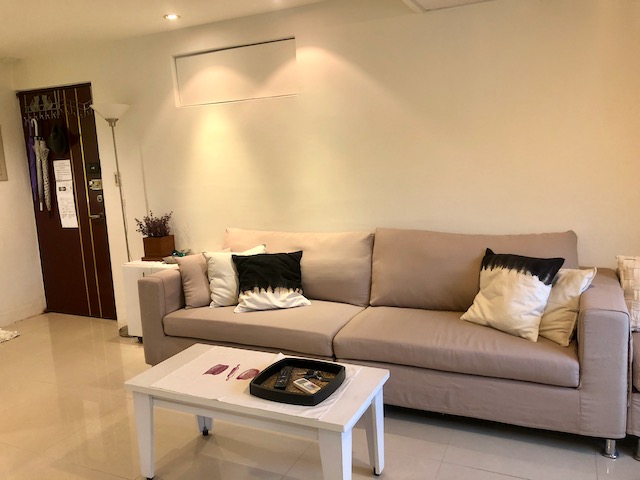
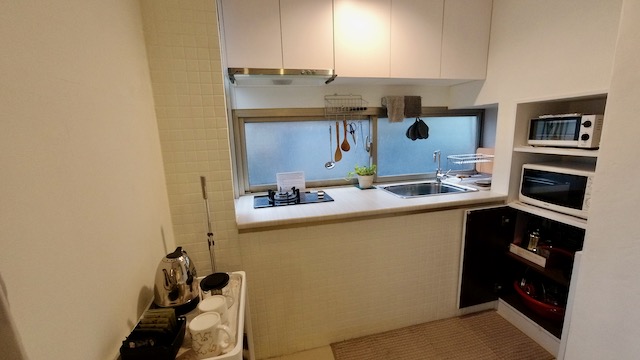
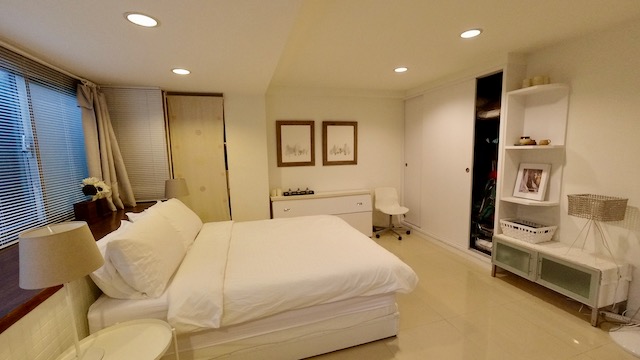
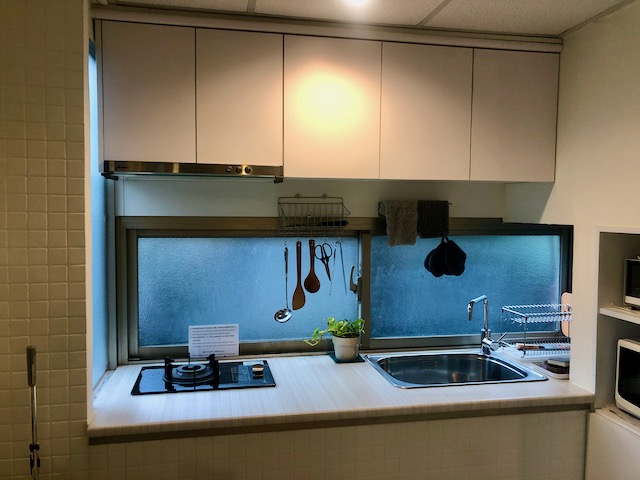

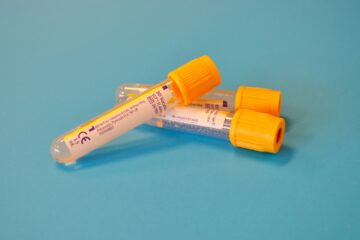
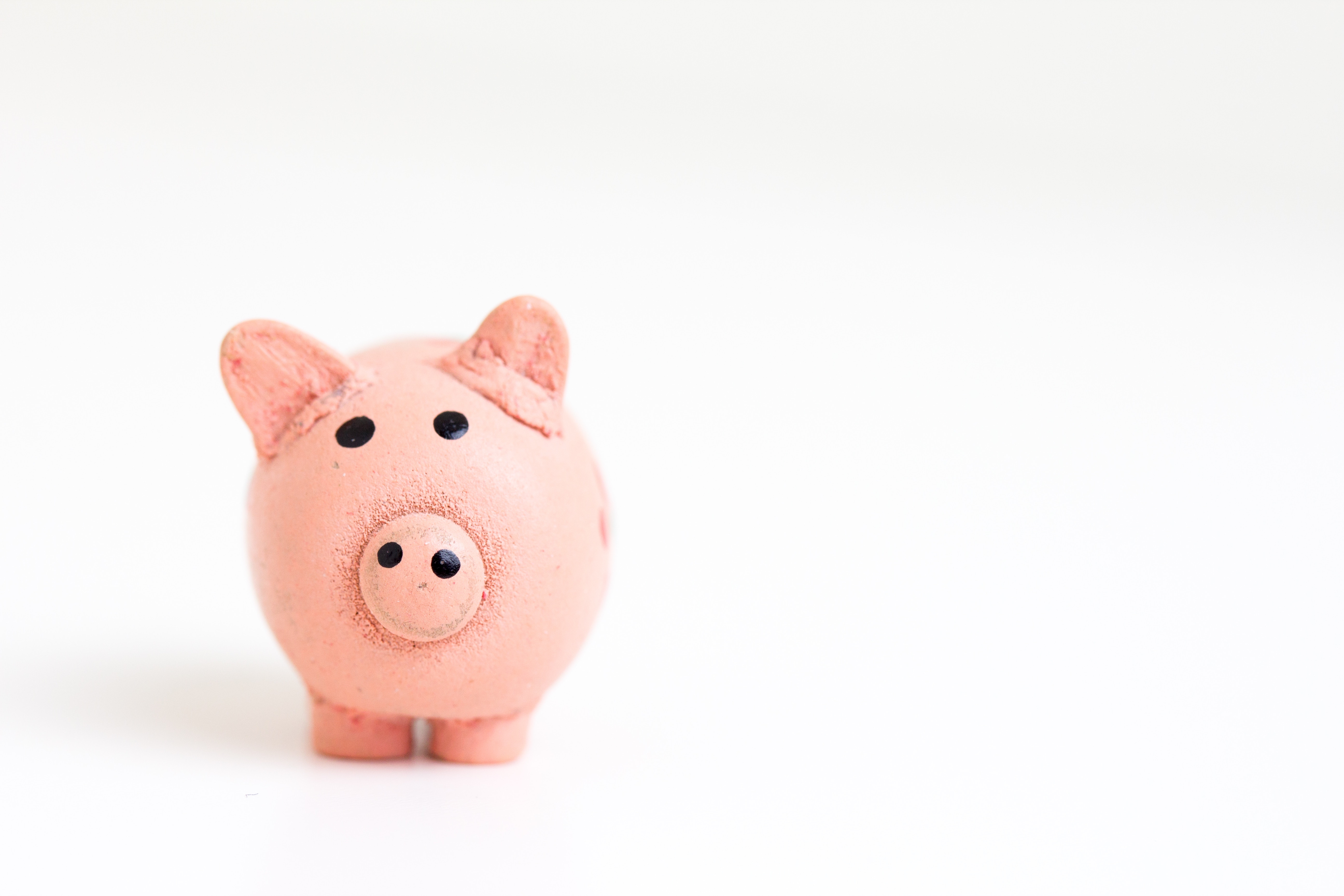
3 Comments
Michelle Cen · August 31, 2021 at 7:01 pm
Love the incredible detail! Always great to see the numbers. Thank you, as always, for sharing so much 🙂 It looks like you both had a wonderful time in Taiwan. This is so helpful as I plan to embark on my slow travel journey. I’ve also shared your resources with others who are similarly inspired 🙂
Mr. Nomad Numbers · September 1, 2021 at 9:12 pm
Thank you Michelle! I’m glad to know that you are enjoying the detailed report and I’m delighted to hear that you have been sharing it with others. Please keep sharing the love as that is the best way to have people rethink the cost of long term travel (and how much they need to save to enjoy such lifestyle!).
Year 5 Nomad Travel - Back to Slow Travel (Part II - The numbers) — Nomad Numbers · July 24, 2023 at 12:59 pm
[…] 3rd Year of Nomadic Travel […]